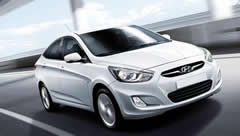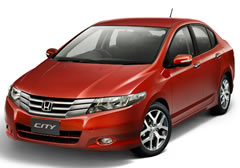Difference between Hyundai Verna Fluidic and Honda City
Key Difference: The Hyundai Verna and Honda City are both sedan cars. Hyundai provides both diesel and petrol variants; whereas, Honda provides only petrol variants in this model.
 The Hyundai Verna is a sedan car that is also marketed as the Accent in many countries and markets. Its production was started in 1995 and it is still in existence. However, many variations were made to the model in these years. The present version of the car was launched in November 2010. It follows the fluidic concept of Hyundai; hence, known as the ‘Hyundai Verna Fluidic’. The Hyundai Verna is available in the 1.4 litre and 1.6 litre petrol engine; as well as 1.4 litre and 1.6 litre diesel engine options in various markets. In India, all the four options are available for the customers.
The Hyundai Verna is a sedan car that is also marketed as the Accent in many countries and markets. Its production was started in 1995 and it is still in existence. However, many variations were made to the model in these years. The present version of the car was launched in November 2010. It follows the fluidic concept of Hyundai; hence, known as the ‘Hyundai Verna Fluidic’. The Hyundai Verna is available in the 1.4 litre and 1.6 litre petrol engine; as well as 1.4 litre and 1.6 litre diesel engine options in various markets. In India, all the four options are available for the customers.
 Whereas, the City is also a sedan/subcompact car by Honda. The first generation of the Honda City was launched in 1981 and now it has its fifth generation in the market. The fifth generation Honda City is known as ‘Honda City i-VTEC’ and was launched in September 2008. It has 1.5 litre engine that is available only in the petrol version. The company has announced the launch of Honda City Diesel by 2015 in India. It has features like music system, rear parking sensors, Bluetooth, rear defogger, etc.
Whereas, the City is also a sedan/subcompact car by Honda. The first generation of the Honda City was launched in 1981 and now it has its fifth generation in the market. The fifth generation Honda City is known as ‘Honda City i-VTEC’ and was launched in September 2008. It has 1.5 litre engine that is available only in the petrol version. The company has announced the launch of Honda City Diesel by 2015 in India. It has features like music system, rear parking sensors, Bluetooth, rear defogger, etc.
Comparison between Hyundai Verna Fluidic and Honda City:
|
|
Hyundai Verna |
Honda City |
|
Engine Displacement (CC) |
Petrol: 1396 & 1591 Diesel: 1396 & 1582 |
1497 |
|
No. Of Cylinders |
4 |
4 |
|
Max Power (PS) |
Petrol 1.4: 107PS @6300rpm Petrol 1.6: 123PS @6300rpm Diesel 1.4: 88bhp@4000rpm Diesel 1.6: 128PS @4000rpm |
118 PS @6600 rpm |
|
Max Torque (NM) |
Petrol 1.4: 138Nm @5000rpm Petrol 1.6: 155Nm @4200rpm Diesel 1.4: 380Nm@1750-2750 Diesel 1.6: 265Nm @1900rpm |
146 Nm @4800 rpm |
|
Transmission |
Manual and Automatic |
Manual and Automatic |
|
No of gears (Gears) |
Manual: 5; and 6 in Diesel 1.6 Automatic: 4 |
5 |
|
Fuel Type |
Petrol and Diesel |
Petrol |
|
Fuel Tank Capacity (litre) |
43 |
42 |
|
Turning Radius (metre) |
5.2 M |
5.3 |
|
Ground Clearance |
170 mm |
165 mm |
|
Boot Space (litre) |
454 |
506 |
|
Length (mm) |
4,370 |
4,440 |
|
Width (mm) |
1,700 |
1,695 |
|
Height (mm) |
1,475 |
1,485 |
|
Wheelbase (mm) |
2,570 |
2,550 |
|
Front Suspension |
Petrol and Diesel 1.4: McPherson strut with stabilizer bar Petrol and Diesel 1.6: McPherson strut with coil spring |
McPherson strut with stabilizer, coil spring |
|
Rear Suspension |
Coupled torsion beam axle |
Torsion beam axle with stabilizer, coil spring |
|
Front Brake Type |
Disc |
Disc |
|
Rear Brake Type |
Disc; Drum in Petrol 1.4 |
Drum |
|
Front Tyres |
Petrol and Diesel 1.4: Tubeless, 185 / 65 R15” Petrol and Diesel 1.6: Tubeless, 195 / 55 R16” |
Tubeless, 175 / 65 R15” |
|
Rear Tyres |
Petrol and Diesel 1.4: Tubeless, 185 / 65 R15” Petrol and Diesel 1.6: Tubeless, 195 / 55 R16” |
Tubeless, 175 / 65 R15” |
|
0-60 (seconds) |
Petrol 1.4: N/A Petrol 1.6: 5.24 Diesel 1.4: N/A Diesel 1.6: N/A |
4.95 |
|
0-100 (seconds) |
Petrol 1.4: N/A Petrol 1.6: 11.48 Diesel 1.4: N/A Diesel 1.6: N/A |
10.66 |
|
Top Speed (KPH) |
Petrol 1.4: N/A Petrol 1.6: 190 Diesel 1.4: N/A Diesel 1.6: 190 |
198 |
|
Seating Capacity (Person) |
5 |
5 |
|
ABS(Anti-Lock Braking System) |
Petrol 1.4: No Petrol 1.6: Yes Diesel 1.4: Yes Diesel 1.6: Yes |
Yes |
|
EBD (Electronic Brake-forceDistribution) |
Petrol 1.4: No Petrol 1.6: Yes Diesel 1.4: Yes Diesel 1.6: Yes |
Yes |
|
Electronic Stability Program |
No |
No |
|
Brake Assist |
Only in Diesel 1.6 MT & AT and Petrol 1.6 AT |
No |
|
Traction Control System |
No |
No |
|
Airbags |
Petrol 1.4: No Petrol 1.6: 1 (Driver Only) Diesel 1.4: 6 Airbags Diesel 1.6: 6 Airbags |
2 (Driver & Co-Driver) |
|
Steering Type |
EPS (Electronic Power Steering) with Tilt feature |
EPS (Electronic Power Steering) with Tilt feature |
|
Cruise Control |
No |
Yes |
Note: Comparison is made between the top models and may vary among different markets.
Image Courtesy: motoroids.com, carhubindia.com









Comments
excellent post, very informative. I wonder why the other experts of this sector don't realize this. You must continue your writing. I'm confident, you've a great readers' base already!
joe cross juicer
Wed, 12/11/2013 - 09:22
Add new comment